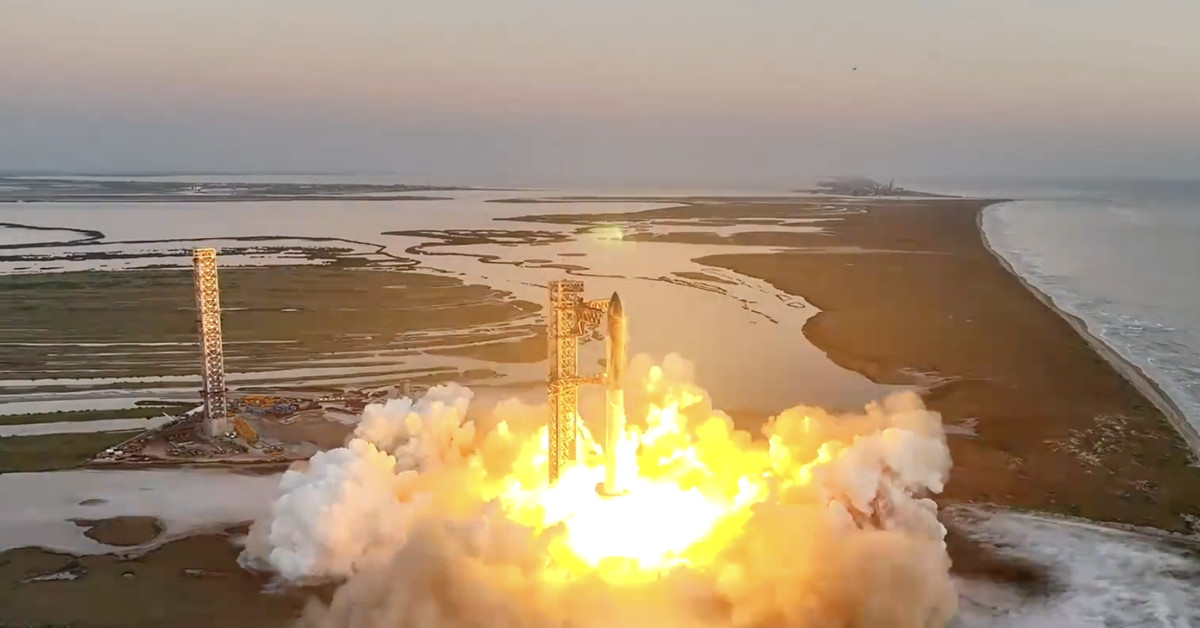Business
SpaceX’s Starship test completes with a remarkable ‘chopstick’ booster catch

SpaceX’s Starship spacecraft splashed down in the Indian Ocean a little over an hour after its 8:25AM ET launch from South Texas. Almost seven minutes following liftoff, the Super Heavy booster returned to its launchpad, where the launch tower caught it using arms that SpaceX has nicknamed the “chopsticks.”
The remarkable catch was a first for SpaceX and an important step toward making the Super Heavy booster a fully reusable launch system just like SpaceX’s Falcon 9 rockets. The booster completed a similar set of maneuvers to today’s during its previous flight test in June, when it splashed down in the Gulf of Mexico, instead.
Today’s flight test, which was delayed 25 minutes while SpaceX waited for its launch range to be cleared of boats, marks the second full Starship launch, flight, and return to Earth. The craft reentered the Earth’s atmosphere about 45 minutes after liftoff and carried out a “soft” splashdown in the Indian Ocean at 9:30AM ET. An explosion rocked the craft just after that.
SpaceX redesigned Starship’s heat shield for this test after Starship lost fragments of its shielding during reentry in June. The company used new heat shielding tiles and added an extra backup ablative layer, as ArsTechnica described last week.
The Federal Aviation Administration (FAA) gave SpaceX approval for the test flight only yesterday. It had originally expected to clear this launch next month, but the FAA and its partner agencies reportedly carried out their assessments of SpaceX’s preparations faster than anticipated.
Update October 13th: Updated to reflect that Starship has splashed down in the Indian Ocean.
Business
The Optimus robots at Tesla’s Cybercab event were humans in disguise

Tesla made sure its Optimus robots were a big part of its extravagant, in-person Cybercab reveal last week. The robots mingled with the crowd, served drinks to and played games with guests, and danced inside a gazebo. Seemingly most surprisingly, they could even talk. But it was mostly just a show.
It’s obvious when you watch the videos from the event, of course. If Optimus really was a fully autonomous machine that could immediately react to verbal and visual cues while talking, one-on-one, to human beings in a dimly lit crowd, that would be mind-blowing.
Attendee Robert Scoble posted that he’d learned humans were “remote assisting” the robots, later clarifying that an engineer had told him the robots used AI to walk, spotted Electrek. Morgan Stanley analyst Adam Jonas wrote that the robots “relied on tele-ops (human intervention)” in a note, the outlet reports.
There are obvious tells to back those claims up, like the fact that the robots all have different voices or that their responses were immediate, with gesticulation to match.
It doesn’t feel like Tesla was going out of its way to make anyone think the Optimus machines were acting on their own. In another video that Jalopnik pointed to, an Optimus’ voice jokingly told Scoble that “it might be some” when he asked it how much it was controlled by AI.
Another robot — or the human voicing it — told an attendee in a stilted impression of a synthetic voice, “Today, I am assisted by a human,” adding that it’s not fully autonomous. (The voice stumbled on the word “autonomous.”)
Musk first announced Tesla’s humanoid robot by bringing what was very clearly a person in a robot suit on stage, so it’s no surprise that the Optimuses (Optimi? Optimodes?) at last week’s event were hyperbolic in their presentation. And people who went didn’t seem to feel upset or betrayed by that. But if you were hoping to have any sense of how far along Tesla truly is in its humanoid robotics work, the “We, Robot” event wasn’t the place to look.
Business
X blocked hacked JD Vance dossier links after the Trump campaign flagged it


The Presidential campaign of Donald Trump asked X to stop links to a story containing VP nominee JD Vance’s hacked dossier from circulating before X chose to block them, reports The New York Times. X had cited its “rules on posting unredacted private personal information” as its justification for suspending the reporter who first published the dossier in his story.
That’s a markedly different set of actions than those Musk took two years ago after criticizing Twitter’s decision to suppress a 2020 news story about Hunter Biden’s laptop. He called the choice “a violation of the Constitution’s First Amendment” and seeded internal documents related to the decision to certain journalists to report on — which doxxed people in the process.
T…
Business
RedCap, the 5G for wearables and IoT, will get its first devices soon

Both T-Mobile and AT&T have plans to release their first devices soon that run on RedCap, a 5G specification that is tooled for Internet of Things devices, according to Fierce Wireless.
What is RedCap? Great question! Also called “reduced capability” or NR-Light, RedCap is a low-bandwidth version of 5G that’s expected to make certain devices, like wearables, sensors, or surveillance cameras simpler and more power efficient, according to an Oracle document. That could mean cheaper cellular-connected smartwatches, XR glasses, or other portable products that don’t need high-powered antennas and fast throughput last longer on a charge.
AT&T, which began testing the spec on its own network early this year, reportedly plans to release its first NR-Light devices in 2025, Fierce Wireless writes. T-Mobile will launch one of its own before this year is out.
It’s not clear what those devices will be, but AT&T AVP of device architecture Jason Silkes has hinted at what early NR-Light products could look like, telling Fierce in June that the first RedCap devices will probably be cheap mobile hotspots and dongles. Indeed, TCL announced a 5G USB dongle last week, catchily named the TCL Linkport IK511.
Early products could use a modem chipset Qualcomm launched last year called the Snapdragon X35. It listed several companies in its announcement, including T-Mobile and AT&T, that plan to use the modem in future products. Perhaps we’ll hear more during CES early next year. Let the (slow) race to 5G begin.





